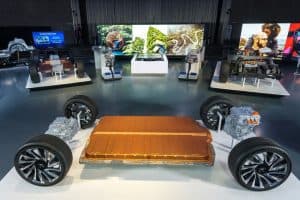
Every battery maker is working to improve energy density (the amount of electricity stored in their batteries). But until there is a dramatic breakthrough, the vast majority of the EVs coming to market in the next five years, and perhaps through 2030, will be powered by variations on the two types of lithium-ion cells already for sale.
The first kind uses cobalt, nickel, manganese, and aluminum in its cathode, or positive electrode. The proportions of each element vary, with the goal of reducing the amount of pricey, high-demand cobalt while continuing to boost energy density and power output. GM’s new Ultium NMCA cells, for example, use 70 percent less cobalt, increasing the proportion of nickel and aluminum.
The second cell type for EVs of the 2020s will use lithium iron-phosphate (LiFP) cathodes. Long a favorite of Chinese battery makers, LiFP cells cost less, use abundant minerals, and are less fire-prone under extreme conditions. Ten years of improvements in their energy density have made them practical for use in the lowest-range and least expensive EVs. Tesla uses them in low-end versions of the Model 3, and it’s worth noting that Teslas fitted with LiFP cells charge to 100 percent every time, suggesting that Tesla has more confidence in the longevity and durability of the cells to survive full charges.
On the other side, heavy research is going into advances in anodes, or negative electrodes. The hope is that a switch to carbon composites or even silicon will boost energy density up to 10 times that of today’s graphite anodes.
The breakthrough most EV makers are hoping for is the solid-state cell, named for its solid electrolyte, or the conductive material between cathode and anode that is typically liquid or polymer in today’s cells. Solid-state cells are expected to be more energy-dense, safer, and ultimately perhaps the favored choice. But we won’t see them in production cars until at least 2025, and even then only in expensive, low-volume models.
Toyota is putting a large effort into making solid-state cells practical for high-volume production. The automaker says its first vehicle with solid-state cells will launch by mid-decade. Hybrid vehicles, with smaller batteries made at higher volumes, will likely get them first.
Solid-state cells face big hurdles in material-cost reduction, setting up production lines, and boosting their advantages so that their price is competitive with older, better-known cells that have benefited from years of refinement and economies of scale. One challenge for solid-state cells: extending their lifespan to several thousand full discharge cycles, an obvious EV prerequisite.
Meanwhile, every automaker has committed billions of dollars to creating dedicated cell-fabrication sites, often near assembly plants for the cars they will power. In January, GM announced a third joint-venture plant with longtime cell partner LG, with the new site in Lansing, Michigan, joining production facilities in Lordstown, Ohio, and Spring Hill, Tennessee.
This content is created and maintained by a third party, and imported onto this page to help users provide their email addresses. You may be able to find more information about this and similar content at piano.io
